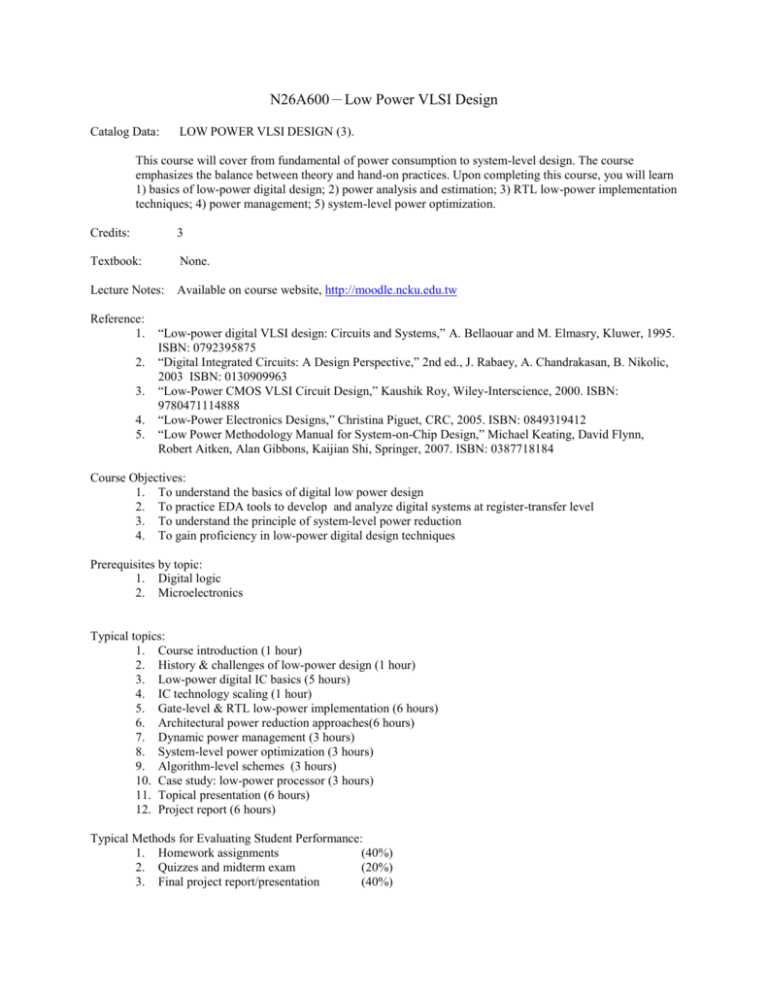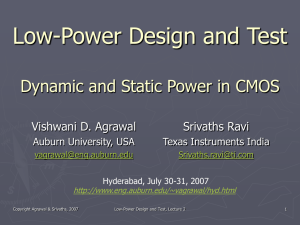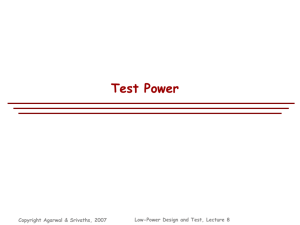EE 618 - Monolithic Microwave Integrated Circuit Design
advertisement

N26A600-Low Power VLSI Design Catalog Data: LOW POWER VLSI DESIGN (3). This course will cover from fundamental of power consumption to system-level design. The course emphasizes the balance between theory and hand-on practices. Upon completing this course, you will learn 1) basics of low-power digital design; 2) power analysis and estimation; 3) RTL low-power implementation techniques; 4) power management; 5) system-level power optimization. Credits: 3 Textbook: None. Lecture Notes: Available on course website, http://moodle.ncku.edu.tw Reference: 1. 2. 3. 4. 5. “Low-power digital VLSI design: Circuits and Systems,” A. Bellaouar and M. Elmasry, Kluwer, 1995. ISBN: 0792395875 “Digital Integrated Circuits: A Design Perspective,” 2nd ed., J. Rabaey, A. Chandrakasan, B. Nikolic, 2003 ISBN: 0130909963 “Low-Power CMOS VLSI Circuit Design,” Kaushik Roy, Wiley-Interscience, 2000. ISBN: 9780471114888 “Low-Power Electronics Designs,” Christina Piguet, CRC, 2005. ISBN: 0849319412 “Low Power Methodology Manual for System-on-Chip Design,” Michael Keating, David Flynn, Robert Aitken, Alan Gibbons, Kaijian Shi, Springer, 2007. ISBN: 0387718184 Course Objectives: 1. To understand the basics of digital low power design 2. To practice EDA tools to develop and analyze digital systems at register-transfer level 3. To understand the principle of system-level power reduction 4. To gain proficiency in low-power digital design techniques Prerequisites by topic: 1. Digital logic 2. Microelectronics Typical topics: 1. Course introduction (1 hour) 2. History & challenges of low-power design (1 hour) 3. Low-power digital IC basics (5 hours) 4. IC technology scaling (1 hour) 5. Gate-level & RTL low-power implementation (6 hours) 6. Architectural power reduction approaches(6 hours) 7. Dynamic power management (3 hours) 8. System-level power optimization (3 hours) 9. Algorithm-level schemes (3 hours) 10. Case study: low-power processor (3 hours) 11. Topical presentation (6 hours) 12. Project report (6 hours) Typical Methods for Evaluating Student Performance: 1. Homework assignments (40%) 2. Quizzes and midterm exam (20%) 3. Final project report/presentation (40%) Course Policy: 1. NO late submission will be accepted! 2. To get credit for your homework assignments, your submissions must be done professionally and seriously. Your official name, course number and homework number must be visibly shown in each assignment. 3. All examines are closed-book exams. Some complex information will be provided if needed. NO calculator is allowed. 4. There will be no make-up exams (in very special circumstances, written excuse and official proofs are required for make-up exams). 5. Encourage you to discuss assigned problems with peers 6. Must complete his/her assignment independently or as specified 7. Any person/team who is found to be dishonesty in laboratory assignments, examines/quizzes, the involved person(s) will receive a “0” on the evaluated instrument (exam, lab work, etc.) Computer Usage: Verilog, NC-Verilog, Design Vision, PrimeTime will be routinely required for solving homework problems. Laboratory projects (including major items of equipment and instrumentation used): None Contribution of course to meeting the professional component: 1. 10% Math science 2. 80% Electrical engineering 3. 10% others, EDA tool training and oral presentation Relationship of course to program outcomes: Outcome 1: Ability to apply knowledge of math, science and engineering to solve problems. Outcome 2: Ability to design and implement experiments, as well as analyze the results Outcome 3: Proficiency in the use of computer and other modern tools to solve engineering problems. Outcome 7: Ability to understand up-to-date electrical engineering issues and impacts on global society Prepared by: Lih-Yih Chiou Date:___07/30/2011__











